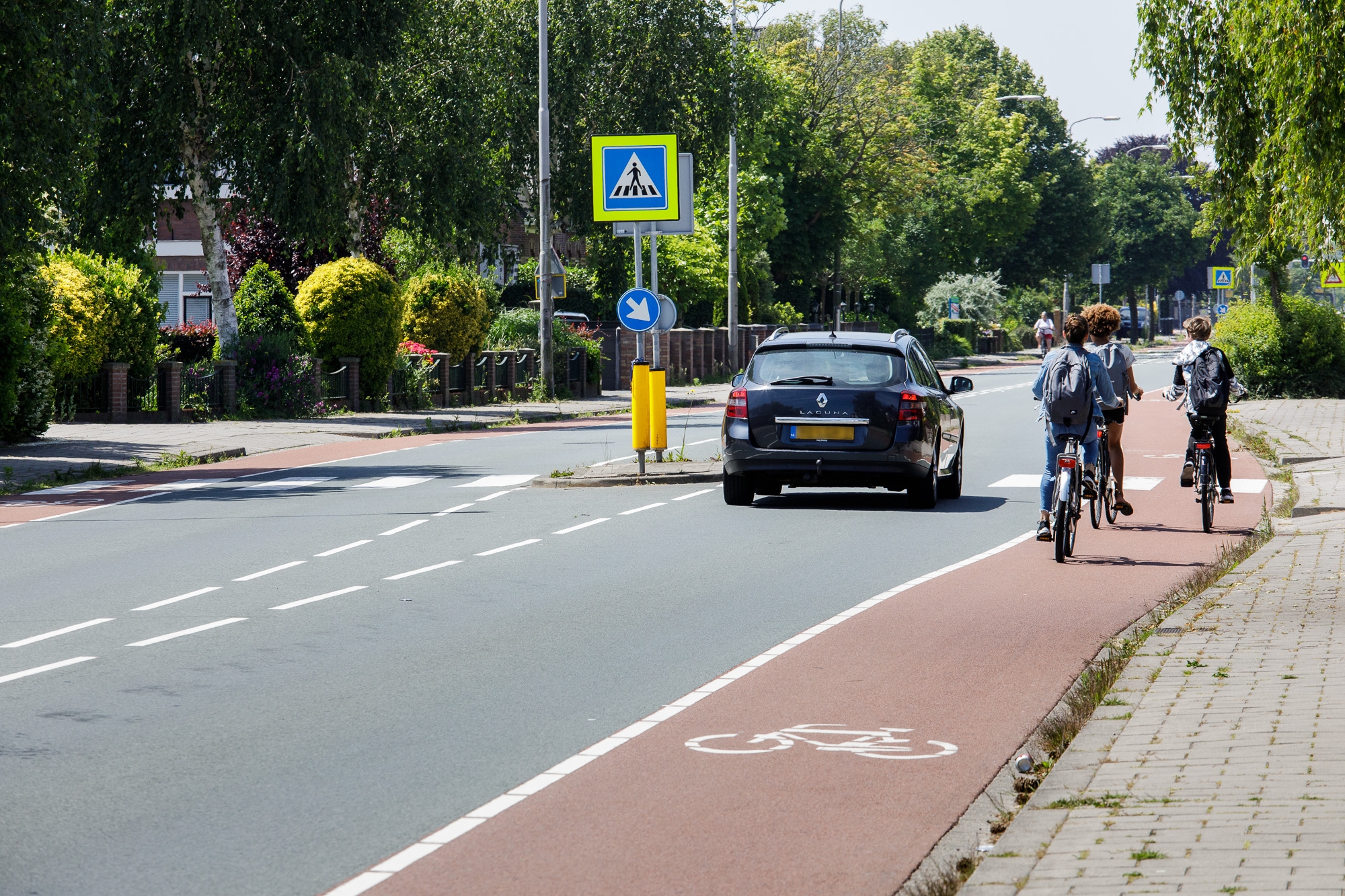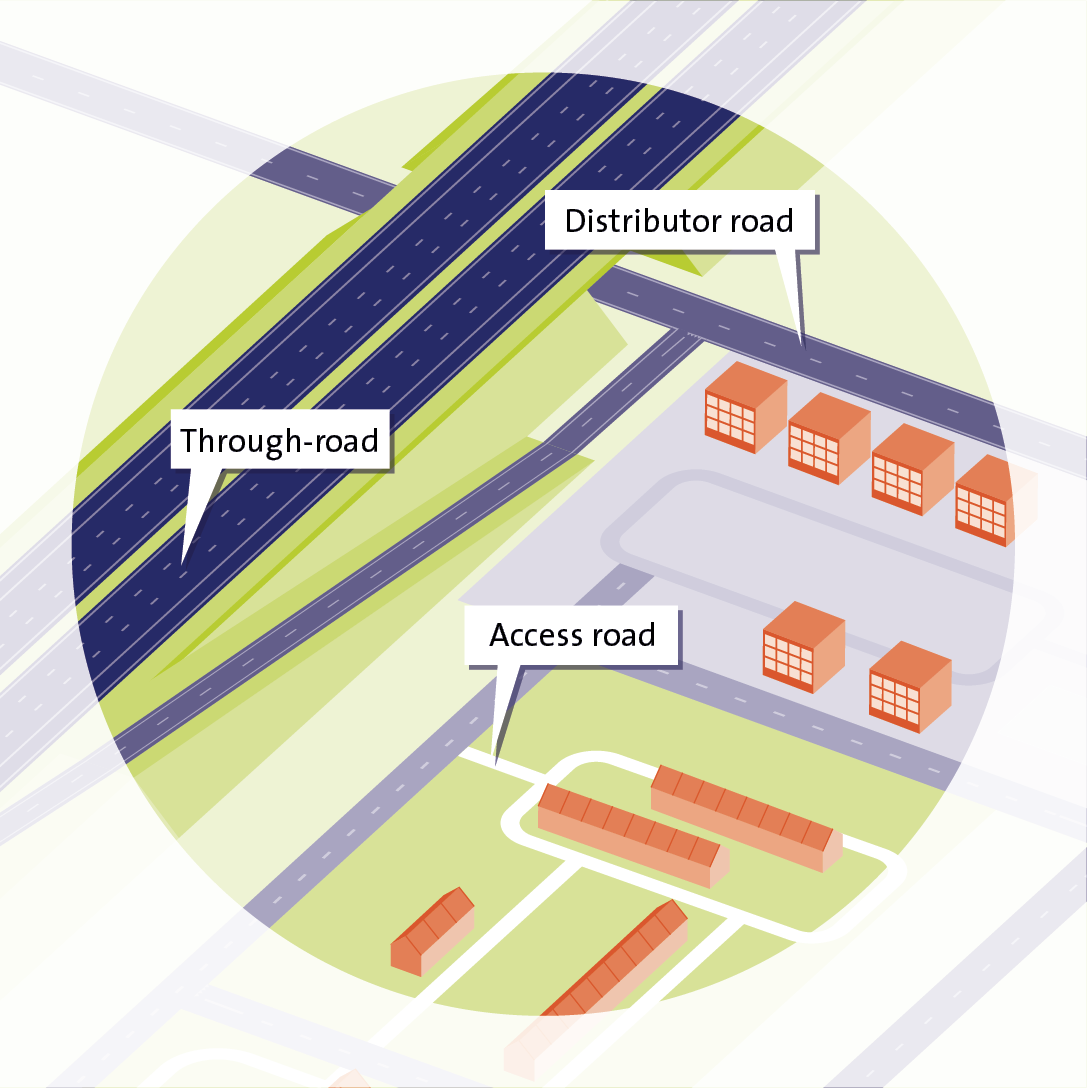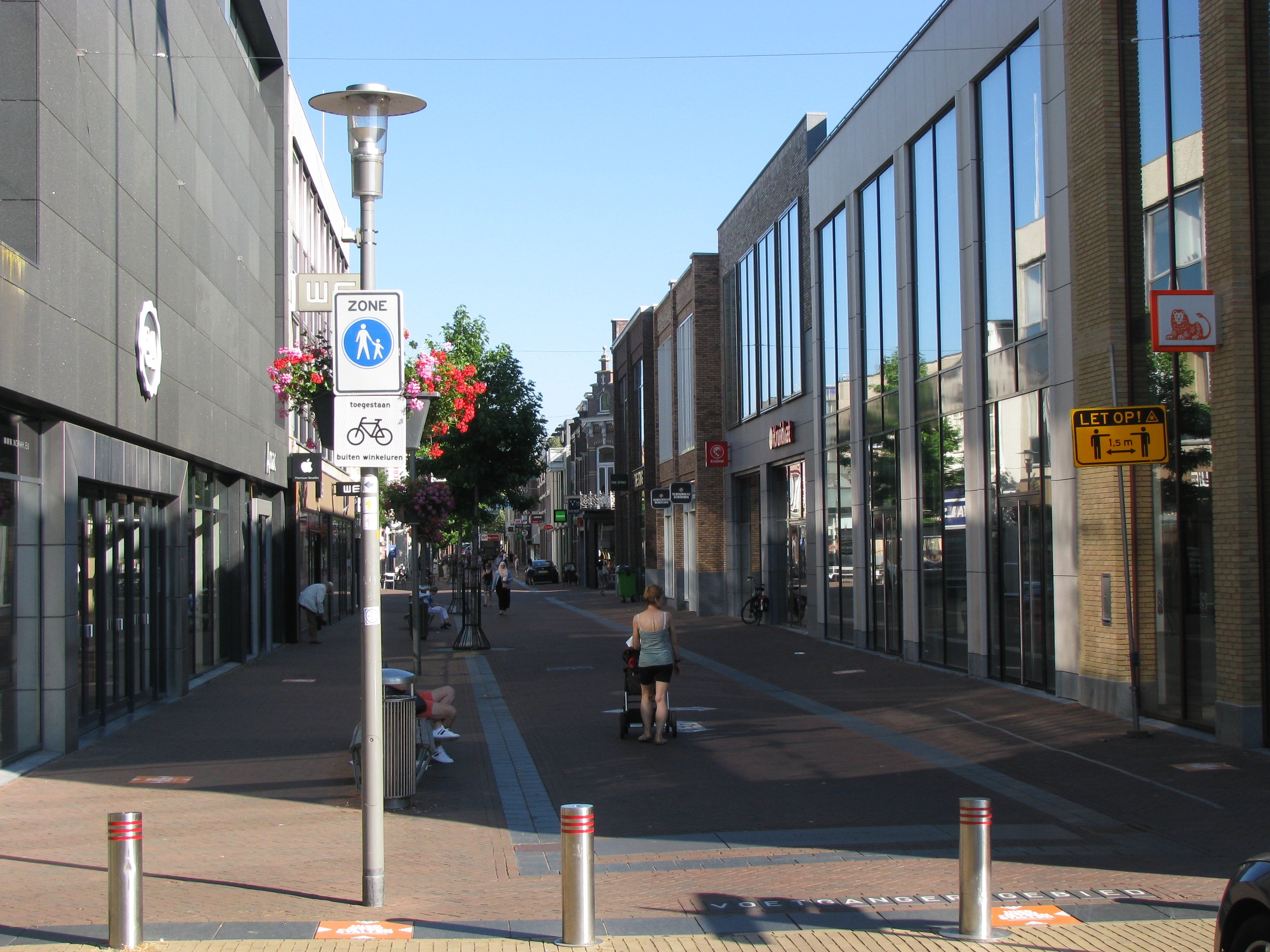Below you will find the list of references that are used in this fact sheet. All sources used can be consulted or retrieved via our Library portal . Here you can also find more literature on this subject.
[1]. Schepers, J.P. & Methorst, R. (2020). Voetgangersveiligheid. Verkenning van onveiligheid, oorzaken en beleidsmogelijkheden [Pedestrian safety. Exploration of the level of unsafety, its causes and policy options. R-2020-4.[Summary in English]. SWOV, Den Haag.
[2]. Weijermars, W.A.M., Goede, M. de, Goldenbeld, C., Decae, R.J., et al. (2019). Monitor Verkeersveiligheid 2019 – Achtergrondinformatie en onderzoeksverantwoording. R-2019-22A. SWOV, Den Haag.
[3]. Godefrooij, H., Hal, E. van & Temme, R. (2005). Fietsers in voetgangersgebieden. Feiten en richtlijnen. Publicatienummer 8. Fietsberaad, Ede.
[4]. CROW (2016). Ontwerpwijzer fietsverkeer. Publicatie 351. CROW Kenniscentrum voor verkeer, vervoer en infrastructuur, Ede.
[5]. CROW-Fietsberaad (2019). Evaluatie discussienotitie Fietsstraten. Fietsberaadpublicatie 32. CROW-Fietsberaad, Utrecht.
[6]. Davidse, R., Duijvenvoorde, K. van, Louwerse, R., Boele-Vos, M., et al. (2018). Scootmobielongevallen: Hoe ontstaan ze en hoe zijn ze te voorkomen? R-2018-15. SWOV, Den Haag.
[7]. Rosén, E., Stigson, H. & Sander, U. (2011). Literature review of pedestrian fatality risk as a function of car impact speed. In: Accident Analysis & Prevention, vol. 43, nr. 1, p. 25-33.
[8]. Dijkstra, A. (2014). Naar meer veiligheid op kruispunten. Aanbevelingen voor kruispunten van 50-, 80- en 100km/uur-wegen. R-2014-21. SWOV, Den Haag.
[9]. CROW (2012). ASVV 2012 - Aanbevelingen voor verkeersvoorzieningen binnen de bebouwde kom. CROW, Ede.
[10]. CROW (2014). Lopen loont. De voetganger in beleid, ontwerp en beheer. CROW, Ede.
[11]. CROW (2006). Veilig oversteken? Vanzelfsprekend! Toepassing en ontwerp van oversteekvoorzieningen voor voetgangers. Publicatie 226. CROW, Ede.
[12]. Drenth, J. & Wijk, M. (2004). Handboek voor toegankelijkheid. Reed Business Information, Doetinchem.
[13]. Schepers, P., Brinker, B. den, Methorst, R. & Helbich, M. (2017). Pedestrian Falls: A review of the literature and future research directions. In: Journal of Safety Research, vol. 62, p. 227-234.
[14]. Davidse, R., Duijvenvoorde, K. van, Boele, M.J., Doumen, M.J.A., et al. (2014). Letselongevallen van fietsende 50-plussers: Hoe ontstaan ze en wat kunnen we eraan doen? R-2014-3. SWOV, Den Haag.
[15]. Schepers, P. (2013). A safer road environment for cyclists. PhD thesis Technical University Delft TUD, SWOV-Dissertatiereeks. SWOV, Leidschendam.
[16]. Wijlhuizen, G.J., Petegem, J.W.H. van, Goldenbeld, C., Gent, P. van, et al. (2016). Doorontwikkeling CycleRAP-instrument voor veiligheidsbeoordeling fietsinfrastructuur. Doelmatigheid handmatige intensiteitsmetingen, betrouwbaarheid beoordelingen infrastructuur en validiteit van het CycleRAP-instrument. R-2016-11. SWOV, Den Haag.
[17]. Brinker, B. den & Schepers, P. (2018). Bouwstenen voor een comfortabel en vergevingsgezind fietspad. CROW-Fietsberaad, Utrecht.
[18]. Elvik, R., Høye, A., Vaa, T. & Sørensen, M. (2009). The handbook of road safety measures. Second edition. Emerald, UK.
[19]. Keall, M.D. (1995). Pedestrian exposure to risk of road accident in New Zealand. In: Accident Analysis & Prevention, vol. 27, nr. 5, p. 729-740.
[20]. Kraay, J.H. & Slop, M. (1974). Safety of pedestrian crossing facilities. An international comparative research on the effect of variously composed sets of pedestrian crossing facilities (zebra crossings, Signal controlled crossings, grade separated crossings) on pedestrian safety in towns. Publication 1974-2E. SWOV, Voorburg.
[21]. Nygårdhs, S., Fors, C., Eriksson, L. & Nilsson, L. (2010). Field test on visibility at cycle crossings at night. VTI, Linköping.
[22]. Retting, R.A., Ferguson, S.A. & McCartt, A.T. (2003). A review of evidence-based traffic engineering measures designed to reduce pedestrian–motor vehicle crashes. In: American Journal of Public Health, vol. 93, nr. 9, p. 1456-1463.
[23]. Coffin, A. & Morrall, J. (1995). Walking speeds of elderly pedestrians at crosswalks. In: Transportation Research Record, vol. 1487, p. 63-67.
[24]. Overheid.nl (2019). Regeling verkeerslichten. Ministerie van Infrastructuur en Milieu, Den Haag. Accessed on 22-06-2020 at wetten.overheid.nl/BWBR0009151/2019-07-01.
[25]. DfT (2006). Puffin crossings: good practice guide. Release 1. Department for Transport, London.
[26]. Maxwell, A., Kennedy, J., Routledge, I., Knight, P., et al. (2011). Puffin pedestrian crossing accident study. PPR507. Transport Research Laboratory TRL, Crowthorne.
[27]. Webster, N. (2006). The effect of newly installed Puffin crossings on collisions. Transport for London.
[28]. Brinker, B. den, Daams, B., Methorst, R., Smeets, J., et al. (2013). Voetgangerslichten moeten oversteken. Verkeerskunde 3. Accessed on 22-06-2020 at www.verkeerskunde.nl/artikel/voetgangerslichten-moeten-oversteken-vk-3-2013.
[29]. Levelt, P.B.M. (1994). De opinie van voetgangers over de Maastrichtse opstelling [Pedestrian opinion on the alternative 'Maastricht' crossing]. R-94-6. [Summary in English] SWOV, Leidschendam.
[30]. Zegeer, C.V., Stewart, J.R., Huang, H.H., Lagerwey, P.A., et al. (2005). Safety effects of marked versus unmarked crosswalks at uncontrolled locations: Final report and recommended guidelines. FHWA–HRT–04–100. Federal Highway Administration’s (FHWA), Washington.
[31]. FGSV (2010). Empfehlungen für Radverkehrsanlagen ERA. Forschungsgesellschaft für Straßen- und Verkehrswesen FGSV, Köln.
[32]. DfT (2004). Adjacent and shared use facilities for pedestrians and cyclists. Department for Transport, London.
[33]. Wildervanck, C. (2009). Onderzoek naar Shared Space - waarom en hoe. Verkeerskunde. Accessed on 22-06-2020 at www.verkeerskunde.nl/blog/onderzoek-naar-shared-space-waarom-en-hoe.
[34]. Aarts, L. & Dijkstra, A. (2018). DV3 - Achtergronden en uitwerking van de verkeersveiligheidsvisie. De visie Duurzaam Veilig Wegverkeer voor de periode 2018 – 2030 onderbouwd [Sustainable Safety version 3 – Backgrounds and elaboration of the updated road safety vision. Substantiation of the second advanced Sustainable Safety vision for the period 2018-2030]. R-2018-6B. [Summary in English]. SWOV, Den Haag.
[35]. Mansvelder, E., Delbressine, R. & Dijkstra, A. (2013). Hoe verkeersveilig zijn fietsstraten? In: Verkeerskunde, vol. 7, nr. 13.
[36]. Delbressine, R.R.H.L. (2013). The traffic safety of bicycle streets in the Netherlands. Master Thesis Delft University of Technology. Delft.
[37]. Minikel, E. (2012). Cyclist safety on bicycle boulevards and parallel arterial routes in Berkeley, California. In: Accident Analysis and Prevention, vol. 45, p. 241-247.
[38]. Thomas, B. & DeRobertis, M. (2013). The safety of urban cycle tracks. A review of the literature. In: Accident Analysis and Prevention, vol. 52, p. 219-227.
[39]. Welleman, A.G. & Dijkstra, A. (1988). Veiligheidsaspecten van stedelijke fietspaden. Bijdrage aan de werkgroep 'Bromfietsers op fietspaden?.' van de Stichting Centrum voor Regelgeving en Onderzoek in de Grond-, Water- en Wegenbouw en de Verkeerstechniek, C.R.O.W. R-88-20. SWOV, Leidschendam.
[40]. Minnen, J. van (1995). Rotondes en voorrangsregelingen [Roundabouts and the priority rule]. R-95-58. [Summary in English]. SWOV, Leidschendam.
[41]. ANWB (1966). Fietspaden en -oversteekplaatsen. Verkeers-memorandum No. 4. AWNB, Den Haag.
[42]. Rijkswaterstaat (1986). Richtlijnen voor het ontwerpen van niet-autosnelwegen (RONA). Voorlopige richtlijnen voor de aanleg van fietspaden langs wegvakken buiten de bebouwde kom. Rijkswaterstaat Dienst Verkeerskunde, Den Haag.
[43]. Visser, C. (1976). Fietspaden niet altijd even veilig. In: Verkeerskunde, vol. 10, p. 492-494.
[44]. Methorst, R. & Schepers, J.P. (2015). Tweerichtingsfietspaden en Spookrijden. Ministerie van Infrastructuur en Milieu, Directoraat-Generaal Rijkswaterstaat, Water, Verkeer en Leefomgeving WVL, 's-Gravenhage.
[45]. Methorst, R., Schepers, P., Kamminga, J., Zeegers, T., et al. (2017). Can cycling safety be improved by opening all unidirectional cycle paths for cycle traffic in both directions? A theoretical examination of available literature and data. In: Accident Analysis and Prevention, vol. 105, p. 38-43.
[46]. Summala, H., Pasanen, E., Räsänen, M. & Sievänen, J. (1996). Bicycle accidents and drivers' visual search at left and right turns. In: Accident Analysis and Prevention, vol. 28, nr. 2, p. 147-153.
[47]. Haeften, M. van (2010). Het kijkgedrag van automobilisten en fietsers bij kruispunten met een tweerichtingsfietspad. Rijksuniversiteit Groningen, Groningen.
[48]. Schoon, C.C., Doumen, M.J.A. & Bruin, D. de (2008). De toedracht van dodehoekongevallen en maatregelen voor de korte en lange termijn [The circumstances of blind spot crashes and short- and long-term measures. A crash analysis over the years 1997-2007, traffic observations, and surveys among cyclists and lorry drivers]. R-2008-11A. [Summary in English]. SWOV, Leidschendam.
[49]. Minister van IenM (2015). Drukte op het fietspad: brief van de Minister van Infrastructuur en Milieu aan de voorzitter van de Tweede Kamer. IENM/BSK-2015/120559. Ministerie van Infrastructuur en Milieu, 's-Gravenhage.
[50]. Groot-Mesken, J. de, Vissers, L. & Duivenvoorden, C.W.A.E. (2015). Gebruikers van het fietspad in de stad. Aantallen, kenmerken, gedrag en conflicten. R-2015-21. SWOV, Den Haag.
[51]. Gemeente Amsterdam (2014). Brief Snorfiets in Amsterdam. 24 maart 2014. Gemeente Amsterdam, Amsterdam.
[52]. Drolenga, H., Mieras, W., Barelds, R. & Plazier, P. (2020). Onderzoek kwaliteit fietsroutes naar middelbare scholen. Sweco Nederland, De Bilt.
[53]. Munckhof, L. van den, Zengerink, L. & Avest, R. ter (2017). Over drukte valt te twisten. Druktebeleving op het fietspad verkennen en onderzoeken. Fietsberaadpublicatie 30. CROW-Fietsberaad, Utrecht.
[54]. Vedel, S.E., Jacobsen, J.B. & Skov-Petersen, H. (2017). Bicyclists’ preferences for route characteristics and crowding in Copenhagen – A choice experiment study of commuters. In: Transportation Research Part A: Policy and Practice, vol. 100, p. 53-64.
[55]. Methorst, R., Schepers, J.P. & Vermeulen, W. (2011). Snorfiets op het fietspad. Directoraat-Generaal Rijkswaterstaat, Dienst Verkeer en Scheepvaart DVS, Delft.
[56]. RAI (2020). Branche-analyse fietsen. RAI Vereniging, Amsterdam. Accessed on 07-05-2020 at https://www.raivereniging.nl/pers/marktinformatie/branche-analyses/brancheanalyse-fietsen.html.
[57]. Hagenzieker, M.P. & Lubbers, A.J. (1992). Gedragswaarnemingen voor het project ‘Bromfiets op de Rijbaan'. R-92-30. SWOV, Leidschendam.
[58]. Loon, A. van (2001). Evaluatie verkeersveiligheidseffecten ‘Bromfiets op de Rijbaan'. Rijkswaterstaat, Rotterdam.
[59]. Wijlhuizen, G.J., Dijkstra, A., Bos, N.M., Goldenbeld, C., et al. (2013). Educated Guess van gevolgen voor verkeersslachtoffers door maatregel Snorfiets op de rijbaan (SOR) in Amsterdam: een eerste inschatting van effecten gerelateerd aan verkeersveiligheid [Educated Guess about the consequences for casualties as a result of introduction of the measure Light moped in the carriageway (SOR) in Amsterdam: a first estimate of the effects related to road safety]. D-2013-11. [Summary in English] SWOV, Den Haag.
[60]. Davidse, R.J., Duijvenvoorde, K. van, Boele-Vos, M.J., Louwerse, W.J.R., et al. (2019). Scenarios of crashes involving light mopeds on urban bicycle paths. In: Accident Analysis and Prevention, vol. 129, p. 334-341.
[61]. Gemeente Amsterdam (2019). Evaluatierapportage Snorfiets naar de rijbaan. Gemeente Amsterdam, Amsterdam.
[62]. Trafikverket (2019). Analysis of road safety trends 2018. Management by objectives for road safety work towards the 2020 interim targets. 2019:182. Swedish Transport Administration, Trafikverket, Borlänge.
[63]. Kuiken, M. & Schepers, P. (2017). Aanpak veiligheid kruispunten met tweerichtingsfietspaden. CROW-Fietsberaad, Utrecht.
[64]. Kennisnetwerk SPV (2019). Investeren in verkeersveiligheid. Vijf maatregelen om het fundament op orde te krijgen. CROW/SWOV, Utrecht.
[65]. Boggelen, O. van, Schepers, P., Kroeze, P. & Voet, M. van der (2011). Samen werken aan een veilige fietsomgeving. Fietsberaadpublicatie 19. Fietsberaad, Utrecht.
[66]. Zeegers, T., Boggelen, O. van, Morsink, P. & Hengeveld, J. (2015). Evaluatie discussienotitie fiets- en kantstroken. Een praktijkonderzoek op 23 locaties. Fietsberaadpublicatie 28. CROW-Fiets

 Figure 1. Number of road deaths among cyclists and pedestrians between 2000 and 2020 (Source: Statistics Netherlands
Figure 1. Number of road deaths among cyclists and pedestrians between 2000 and 2020 (Source: Statistics Netherlands  Figure 2. Distribution of the number of serious road injuries among cyclists and pedestrians by mode of transport in 2018
Figure 2. Distribution of the number of serious road injuries among cyclists and pedestrians by mode of transport in 2018 Figure 3. Example of a zebra crossing (Photograph: Paul Voorham).
Figure 3. Example of a zebra crossing (Photograph: Paul Voorham). Figure 4. Example of a bike box (Photograph: Paul Schepers).
Figure 4. Example of a bike box (Photograph: Paul Schepers). Figure 5. Functional road classification.
Figure 5. Functional road classification.
 Figure 6. Above: pedestrian light at the beginning of the crossing, the ‘Maastricht position’ (Photograph: Eric Greweldinger). Below: Before and after installing pedestrian lights at the ‘Maastricht position’ in the city of Den Bosch (Photograph: Cyclomedia).
Figure 6. Above: pedestrian light at the beginning of the crossing, the ‘Maastricht position’ (Photograph: Eric Greweldinger). Below: Before and after installing pedestrian lights at the ‘Maastricht position’ in the city of Den Bosch (Photograph: Cyclomedia). Figure 7. Entry to the pedestrian precinct in the city of Apeldoorn (Photograph: Paul Schepers).
Figure 7. Entry to the pedestrian precinct in the city of Apeldoorn (Photograph: Paul Schepers). Figure 8. Example of Shared Space in the city of Drachten (Photograph: Fietsberaad).
Figure 8. Example of Shared Space in the city of Drachten (Photograph: Fietsberaad). Figure 9. Example bicycle highway (Photograph: Fietsberaad).
Figure 9. Example bicycle highway (Photograph: Fietsberaad). Figure 10. Example bicycle street (Photograph: Paul Voorham).
Figure 10. Example bicycle street (Photograph: Paul Voorham). Figure 11. Bicycle track (Photograph: Paul Voorham).
Figure 11. Bicycle track (Photograph: Paul Voorham). Figure 12. Two-way bicycle track with a cyclist coming from the right side from the perspective of the side road of the main road where a cyclist crosses a side street and may be overlooked by drivers coming from the side street (Photograph: Paul Schepers).
Figure 12. Two-way bicycle track with a cyclist coming from the right side from the perspective of the side road of the main road where a cyclist crosses a side street and may be overlooked by drivers coming from the side street (Photograph: Paul Schepers).